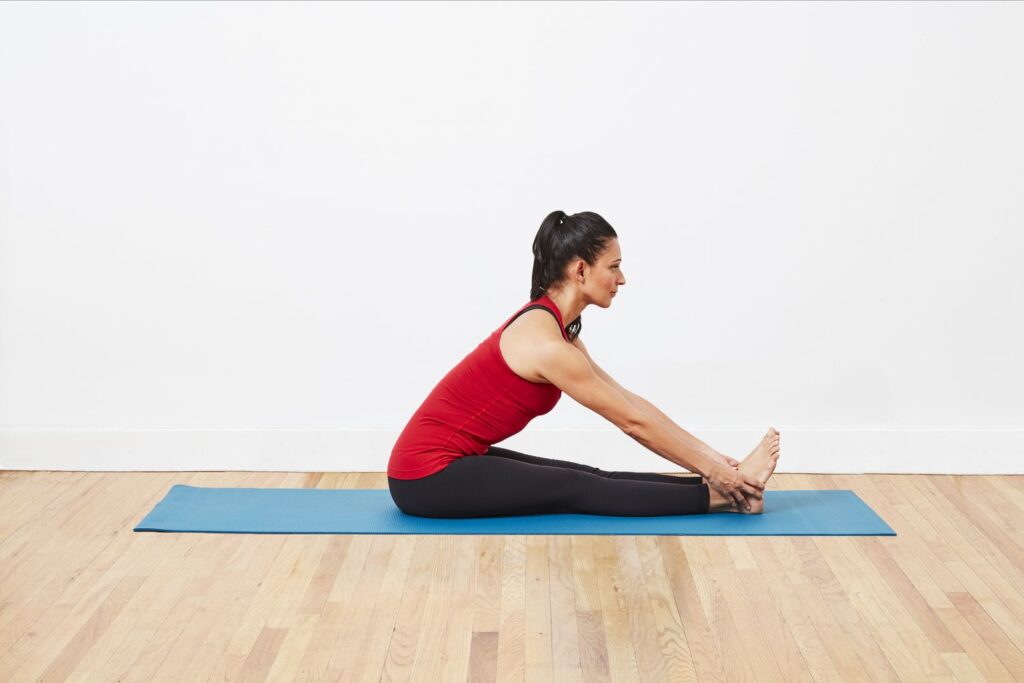
Seated Forward Bend, or Paschimottanasana, is a foundational yoga pose known for its calming effects and deep stretch for the back, hamstrings, and spine. This pose helps to improve flexibility, reduce tension, and promote a sense of mental calm and introspection. Often practiced at the end of a yoga session or as part of a longer sequence, Paschimottanasana is an excellent way to release stress and improve posture. Here’s how to do it, along with its benefits and tips for a safe and effective practice.
How to Do Seated Forward Bend (Paschimottanasana)
- Sit with Your Legs Extended: Begin by sitting on the floor with your legs straight in front of you. Keep your feet together, flexing your toes upward toward the ceiling.
- Sit Up Tall: Sit up tall with your spine straight and your hands resting on your thighs. Engage your core to support the spine.
- Inhale and Lengthen the Spine: Take a deep breath in, lengthening your spine and reaching the crown of your head toward the ceiling. Imagine your torso elongating, creating space between each vertebra.
- Exhale and Reach Forward: As you exhale, gently hinge forward from your hips, keeping your back straight and leading with your chest. Avoid rounding your back as you fold forward.
- Reach for Your Feet or Shins: Depending on your flexibility, grab your feet, ankles, or shins. If you can’t reach your feet comfortably, use a yoga strap around your feet and hold onto it to gently assist the stretch.
- Relax the Neck and Shoulders: Allow your neck to relax, letting your head fall toward your legs. Keep your shoulders relaxed and avoid hunching them up toward your ears.
- Hold and Breathe: Stay in the forward bend for several deep breaths, aiming to deepen the stretch with each exhale. Feel the lengthening of your spine and the gentle release in your back and hamstrings.
To release the pose, slowly roll your torso back up to sitting, one vertebra at a time, keeping your spine long.
Benefits of Seated Forward Bend (Paschimottanasana)
- Stretches the Hamstrings and Lower Back: Paschimottanasana deeply stretches the hamstrings, calves, and lower back, helping to improve flexibility in these areas.
- Lengthens the Spine: By gently folding forward and elongating the spine, this pose helps create space between the vertebrae, promoting better posture and spinal health.
- Calms the Nervous System: As a forward bend, this pose has a calming effect on the mind, helping to reduce anxiety and stress. It can also promote deep relaxation and a sense of mental clarity.
- Relieves Tension in the Neck and Shoulders: This stretch helps release tension in the neck, shoulders, and upper back, areas where stress is often stored.
- Improves Digestion: The compression of the abdomen in this pose can stimulate digestion and improve the functioning of the digestive organs.
- Enhances Focus and Mental Clarity: The introspective nature of this pose encourages mindfulness, making it ideal for calming the mind and improving concentration.
- Improves Posture: Regular practice of Paschimottanasana can help improve posture by lengthening the spine and releasing tightness in the lower back and hips.
Tips for Practicing Seated Forward Bend
- Use a Prop for Comfort: If you have tight hamstrings or a rounded lower back, sit on a folded blanket or bolster to elevate your hips. This will help tilt your pelvis forward and make it easier to maintain a straight back as you bend.
- Focus on Lengthening, Not Just Reaching: The goal of Paschimottanasana is not just to touch your feet but to focus on lengthening your spine. Keep your back straight as you hinge forward, moving from your hips instead of rounding your lower back.
- Avoid Straining: If you feel any discomfort in your lower back or hamstrings, ease out of the stretch. Never force your body into the pose; a gentle, gradual stretch is more effective.
- Breathe Deeply: Keep your breath slow and deep throughout the pose. With each exhale, see if you can release a little more tension in your body, allowing yourself to go deeper into the stretch.
- Be Mindful of Your Neck: Let your neck relax naturally in the pose without forcing your chin toward your chest. This will help avoid any strain on the neck.
Seated Forward Bend (Paschimottanasana) is a wonderful pose for deep stretching and relaxation. By incorporating this posture into your yoga practice, you can improve flexibility, reduce stress, and develop greater mindfulness and body awareness. Whether you are seeking a physical release or a moment of calm, this pose provides a perfect opportunity to reconnect with your body and mind.